Effects of Simulated Warming on Bacterial Community Structure in Litters of Chinese Fir Based on Displacement Test
Abstract
:1. Introduction
2. Materials and Methods
2.1. Study Site
2.2. Experimental Design
2.3. Sequencing of Litter Bacterial Community
2.4. Measurements of Chemical Properties and Enzyme Activities
2.5. Date Analysis
3. Results
3.1. Effect of Warming on the Composition of Bacterial Communities in Litters
3.2. Analysis of Diversity and Biomarkers in Litters
3.3. Effect of Warming on Bacterial Community Function in Litters
3.4. Correlation Analysis of Chemical Properties and Enzyme Activity with Bacterial Community
3.5. Analysis of Importance of Warming on Bacterial Community, Enzyme Activity, and Chemical Properties of Litter
4. Discussion
4.1. Effects of Warming on Bacterial Community Structure in Forest Litters
4.2. Effects of Warming on the Activity of Enzymes in Forest Litter Decomposition
5. Conclusions
Author Contributions
Funding
Data Availability Statement
Conflicts of Interest
References
- Wang, M.; Liu, G.; Xing, Y.; Yan, G.; Wang, Q. Long-Term Nitrogen Addition Accelerates Litter Decomposition in a Larix gmelinii Forest. Forests 2024, 15, 372. [Google Scholar] [CrossRef]
- Xie, P.; Liu, G.; Sun, J.; Guo, C.; Zhu, K.; Zhang, X.; Wang, L. Effects of Simulated warming on litter decomposition and bacterial communities of wetland plants. Acta Ecol. Sin. 2023, 43, 10308–10319. [Google Scholar]
- Zhou, T.J. New physical science behind climate change: What does IPCC AR6 tell us? Innovation 2021, 2, 100173. [Google Scholar] [CrossRef] [PubMed]
- Kolomyts, E.G. Predictive modelling of boreal forest resources in regulation of the carbon cycle and mitigation of the global warming. Int. J. Glob. Warm. 2022, 27, 333–364. [Google Scholar] [CrossRef]
- Park, H.J.; Lim, S.S.; Yang, H.I.; Lee, K.S.; Kwak, J.H.; Park, S.I.; Kim, H.Y.; Lee, S.M.; Choi, W.J. Nitrogen effects on quantity, chemistry, and decomposability of Pinus densiflora and Quercus variabilis litters under elevated CO2 and warming. For. Ecol. Manag. 2020, 473, 118315. [Google Scholar] [CrossRef]
- Verónica, F.; Eric, C. Future increase in temperature more than decrease in litter quality can affect microbial litter decomposition in streams. Oecologia 2011, 167, 279–291. [Google Scholar]
- Liu, X.; Chen, S.; Li, X.; Yang, Z.; Xiong, D.; Xu, C.; Wanek, W.; Yang, Y. Soil warming delays leaf litter decomposition but exerts no effect on litter nutrient release in a subtropical natural forest over 450 days. Geoderma 2022, 427, 116139. [Google Scholar] [CrossRef]
- Liu, G.; Sun, J.; Xie, P.; Guo, C.; Zhu, K.; Tian, K. Climate warming enhances microbial network complexity by increasing bacterial diversity and fungal interaction strength in litter decomposition. Sci. Total Environ. 2023, 908, 168444. [Google Scholar] [CrossRef]
- Zheng, J.; Yang, J.; Jia, H.; Lyu, L.; Langzhen, J.; Zhang, Q.B. Changes of growth-climate relationships of Smith fir forests along an altitudinal gradient. J. For. Res. 2024, 35, 76. [Google Scholar] [CrossRef]
- Salinas, N.; Malhi, Y.; Meir, P.; Silman, M.; Roman, C.R.; Huaman, J.; Salinas, D.; Huaman, V.; Gibaja, A.; Mamani, M.; et al. The sensitivity of tropical leaf litter decomposition to temperature: Results from a large-scale leaf translocation experiment along an elevation gradient in Peruvian forests. New Phytol. 2011, 189, 967–977. [Google Scholar] [CrossRef]
- Klimek, B.; Niklińska, M. Changes in temperature sensitivity of forest litter during decomposition along an altitudinal gradient in temperate mountains—A reciprocal litter transplantation study. Catena 2024, 240, 107977. [Google Scholar] [CrossRef]
- Bohara, M.; Acharya, K.; Perveen, S.; Manevski, K.; Hu, C.; Yadav, R.K.P.; Shrestha, K.; Li, X. In situ litter decomposition and nutrient release from forest trees along an elevation gradient in Central Himalaya. Catena 2020, 194, 104698. [Google Scholar] [CrossRef]
- Sun, Y.; Chen, X.; Zhong, A.; Guo, S.; Zhang, H. Variations in microbial residue and its contribution to SOC between organic and mineral soil layers along an altitude gradient in the Wuyi Mountains. Forests 2023, 14, 1678. [Google Scholar] [CrossRef]
- Huang, Z.; Liu, Q.; An, B.; Wu, X.; Sun, L.; Wu, P.; Liu, B.; Ma, X. Effects of Planting Density on Morphological and Photosynthetic Characteristics of Leaves in Different Positions on Cunninghamia lanceolata Saplings. Forests 2021, 12, 853. [Google Scholar] [CrossRef]
- Xia, L.; Yu, J.; Deng, L.; Li, X.; Zhou, C.; Xu, Y. Researches on Soil Decline of Chinese Fir Plantation. World For. Res. 2018, 31, 37–42. [Google Scholar]
- Sheng, W. On the maintenance of long-term productivity of plantation in China. For. Res. 2018, 31, 1–14. [Google Scholar]
- Wang, X.; Yang, X.; Yang, N.; Xin, X.; Qu, Y.; Zhao, N.; Gao, Y. Effects of litter diversity and composition on litter decomposition characteristics and soil microbial community. Acta Ecol. Sin. 2019, 39, 6264–6272. [Google Scholar]
- Bao, Y.; Dolfing, J.; Li, X.; Chen, R.; Cui, X.; Li, Z.; Lin, X.; Feng, Y. Bacterial interference competition and environmental filtering reduce the fungal taxonomic and functional contribution to plant residue decomposition in anoxic paddy soils. Soil Tillage Res. 2024, 236, 105938. [Google Scholar] [CrossRef]
- Chen, Y.; Lie, Z.; Liu, X.; Li, X.; Wu, T.; Chu, G.; Meng, Z.; Liu, J. The effect of warming on the activity of decomposition enzymes in litter of mixed coniferous and broad-leaved forests in South Asia. Chin. J. Appl. Environ. Biol. 2021, 27, 923–929. [Google Scholar]
- Van Meeteren, M.J.M.; Tietema, A.; van Loon, E.E.; Verstraten, J.M. Microbial dynamics and litter decomposition under a changed climate in a Dutch heathland. Appl. Soil Ecol. 2007, 38, 119–127. [Google Scholar] [CrossRef]
- Rinnan, R.; Stark, S.; Tolvanen, A. Responses of Vegetation and Soil Microbial Communities to Warming and Simulated Herbivory in a Subarctic Heath. J. Ecol. 2009, 97, 788–800. [Google Scholar] [CrossRef]
- Mao, R.; Zhang, X.; Song, C.; Wang, X.; Finnegan, P.M. Plant functional group controls litter decomposition rate and its temperature sensitivity: An incubation experiment on litters from a boreal peatland in northeast China. Sci. Total Environ. 2018, 626, 678–683. [Google Scholar] [CrossRef] [PubMed]
- Wu, X.; Cao, Y.; Jiang, Y.; Chen, M.; Zhang, H.; Wu, P.; Ma, X. Dynamics of Non-Structural Carbohydrates Release in Chinese Fir Topsoil and Canopy Litter at Different Altitudes. Plants 2023, 12, 729. [Google Scholar] [CrossRef]
- Yan, Y.; Li, B.; Huang, Z.; Zhang, H.; Wu, X.; Farooq, T.H.; Wu, P.; Li, M.; Ma, X. Characteristics and Driving Factors of Rhizosphere Bacterial Communities of Chinese Fir Provenances. Forests 2021, 12, 1362. [Google Scholar] [CrossRef]
- Johannes, E.F.; André, N.; Konrad, K.; Lars, N.; Marcel, H. Rapid, real-time sucrase characterization: Showcasing the feasibility of a one-pot activity assay. J. Biotechnol. 2022, 354, 21–33. [Google Scholar]
- Jin, K.; Sleutel, S.; Buchan, D.; Never, S.D.; Cai, D.; Gabriels, D.; Jin, J. Changes of soil enzyme activities under different tillage practices in the Chinese Loess Plateau. Soil Tillage Res. 2009, 104, 115–120. [Google Scholar] [CrossRef]
- Ai, C.; Liang, G.; Sun, J.; Wang, X.; Zhou, W. Responses of extracellular enzyme activities and microbial community in both the rhizosphere and bulk soil to long-term fertilization practices in a fluvo-aquic soil. Geoderma 2012, 173–174, 330–338. [Google Scholar] [CrossRef]
- Contos, P.; Murphy, N.P.; Kayll, Z.J.; Morgan, T.; Vido, J.J.; Decker, O.; Gibb, H. Rewilding soil and litter invertebrates and fungi increases decomposition rates and alters detritivore communities. Ecol. Evol. 2024, 14, e11128. [Google Scholar] [CrossRef] [PubMed]
- Witoon, P.; Tesfaye, W.; Guillaume, L.; Michael, S.; Marek, J.P.; Danuta, K.; Martin, H.; Dirk, K.; François, B. Life in leaf litter: Novel insights into community dynamics of bacteria and fungi during litter decomposition. Mol. Ecol. 2016, 25, 4059–4074. [Google Scholar]
- Song, H.W. Effects of Soil Warming on Litter Decomposition in Subtropical Forests and Its Microbial Mechanisms. Master’s Thesis, Fujian Normal University, Fuzhou, China, 2021. [Google Scholar]
- Kim, H.S.; Lee, S.H.; Young, J.H.; Finneran, K.T.; Kwon, M.J. Diversity and composition of soil Acidobacteria and Proteobacteria communities as a bacterial indicator of past land-use change from forest to farmland. Sci. Total Environ. 2021, 797, 148944. [Google Scholar] [CrossRef]
- Jiang, X.; Ma, D.; Zang, S.; Zhang, D.; Sun, H. Characteristics of soil bacterial and fungal community of typical forest in the Greater Khingan Mountains based on high-throughput sequencing. Microbiol. China 2021, 48, 1093–1105. [Google Scholar]
- Bradford, M.A.; Keiser, A.D.; Davies, C.A.; Mersmann, C.A.; Strickland, M.S. Empirical evidence that soil carbon formation from plant inputs is positively related to microbial growth. Biogeochemistry 2013, 113, 271–281. [Google Scholar] [CrossRef]
- Zheng, R.; Wang, C.; Liu, R.; Cai, R.; Sun, C. Physiological and metabolic insights into the first cultured anaerobic representative of deep-sea Planctomycetes bacteria. eLife 2024, 12, 89874. [Google Scholar] [CrossRef] [PubMed]
- Wu, D.; Zhang, Z.M.; Yu, Z.D.; Zhu, L. Optimization of F/M ratio for stability of aerobic granular process via quantitative sludge discharge. Bioresour. Technol. 2018, 252, 150–156. [Google Scholar] [CrossRef] [PubMed]
- Zhao, P.; Zhou, J.; Lin, K.; Zhang, Q.; Yuan, P.; Zeng, X.; Su, Y.; Xu, J.; Chen, Y.; Yang, Y. Effect of different altitudes on soil microbial biomass and community structure of Pinus taiwanensis forest in mid-subtropical zone. Acta Ecol. Sin. 2019, 39, 2215–2225. [Google Scholar]
- Yu, F.; Liang, J.; Shi, J.; Wang, S.; Lu, J. Effects of canopy damaged on the soil CO2 fixation bacterial community structure in Xiaokeng Forest Farm. Microbiol. China 2017, 44, 2297–2306. [Google Scholar]
- Zhao, B.; Xing, P.; Wu, Q. Interactions between bacteria and fungi in macrophyte leaf litter decomposition. Environ. Microbiol. 2020, 23, 1130–1144. [Google Scholar] [CrossRef] [PubMed]
- Zhou, X.; Chen, C.; Wang, Y.; Xu, Z.; Han, H.; Li, L.; Wan, S. Warming and increased precipitation have differential effects on soil extracellular enzyme activities in a temperate grassland. Sci. Total Environ. 2013, 444, 552–558. [Google Scholar] [CrossRef] [PubMed]
- Liu, G.; Sun, J.; Xie, P.; Guo, C.; Li, M.; Tian, K. Mechanism of bacterial communities regulating litter decomposition under climate warming in temperate wetlands. Environ. Sci. Pollut. Res. Int. 2023, 30, 60663–60677. [Google Scholar] [CrossRef] [PubMed]
- Meena, C.; Hens, C.; Acharyya, S.; Haber, S.; Boccaletti, S.; Barzel, B. Emergent stability in complex network dynamics. Nat. Phys. 2023, 19, 1033–1042. [Google Scholar] [CrossRef]
- Ren, C.; Zhao, F.; Shi, Z.; Chen, J.; Han, X.; Yang, G.; Feng, Y.; Ren, G. Differential responses of soil microbial biomass and carbon-degrading enzyme activities to altered precipitation. Soil Biol. Biochem. 2017, 115, 1–10. [Google Scholar] [CrossRef]
- Zhang, M.; Chen, L.; Zhang, J.; Yuan, W.; Liu, H.; Li, X.; Zhang, Y. Dynamics of microbial biomass carbon and nitrogen during foliar litter decomposition under artificial forest gap in Pinus massoniana plantation. Chin. J. Appl. Ecol. 2016, 27, 672–680. [Google Scholar]
- Chen, M.; Zhu, X.; Zhao, C.; Yu, P.; Abulaizi, M.; Jia, H. Rapid microbial community evolution in initial Carex litter decomposition stages in Bayinbuluk alpine wetland during the freeze–thaw period. Ecol. Indic. 2021, 121, 107180. [Google Scholar] [CrossRef]
- Kivlin, S.N.; Treseder, K.K. Soil extracellular enzyme activities correspond with abiotic factors more than fungal community composition. (Special Issue: Enzymes in biogeochemical cycles: Integrating experimental data, theory, and models). Biogeochemistry 2014, 117, 23–37. [Google Scholar] [CrossRef]
- Xu, Z.; Tang, Z.; Wang, C.; Xiong, P.; Cao, G.; Liu, Q. Effects of simulated warming on soil enzyme activities in two subalpine coniferous forests in west Sichuan. Chin. J. Appl. Ecol. 2010, 21, 2727–2733. [Google Scholar]
- Sardans, J.; Peñuelas, J.; Estiarte, M. Changes in soil enzymes related to C and N cycle and in soil C and N content under prolonged warming and drought in a Mediterranean shrubland. Appl. Soil Ecol. 2007, 39, 223–235. [Google Scholar] [CrossRef]
- Meng, C.; Tian, D.; Zeng, H.; Li, Z.; Chen, H.; Niu, S. Global meta-analysis on the responses of soil extracellular enzyme activities to warming. Sci. Total Environ. 2020, 705, 135992. [Google Scholar] [CrossRef] [PubMed]
- Chen, X.; Wang, G.; Yang, Y.; Yang, Y. The response of soil surface enzyme activities to short time warming and litter decomposition in mountain forest. Acta Ecol. Sin. 2015, 35, 7071–7079. [Google Scholar]
- Tan, B.; Wu, F.; Yang, W.; Yu, S.; Liu, L.; Wang, A.; Yang, Y. Activities Soil oxidoreductase and their response to seasonal freeze-thaw in the subalpine/alpine forests of western Sichuan. Acta Ecol. Sin. 2012, 32, 6670–6678. [Google Scholar] [CrossRef]
- Suseela, V.; Tharayil, N.; Xing, B.S.; Dukes, J.S. Labile compounds in plant litter reduce the sensitivity of decomposition to warming and altered precipitation. New Phytol. 2013, 200, 122–133. [Google Scholar] [CrossRef]
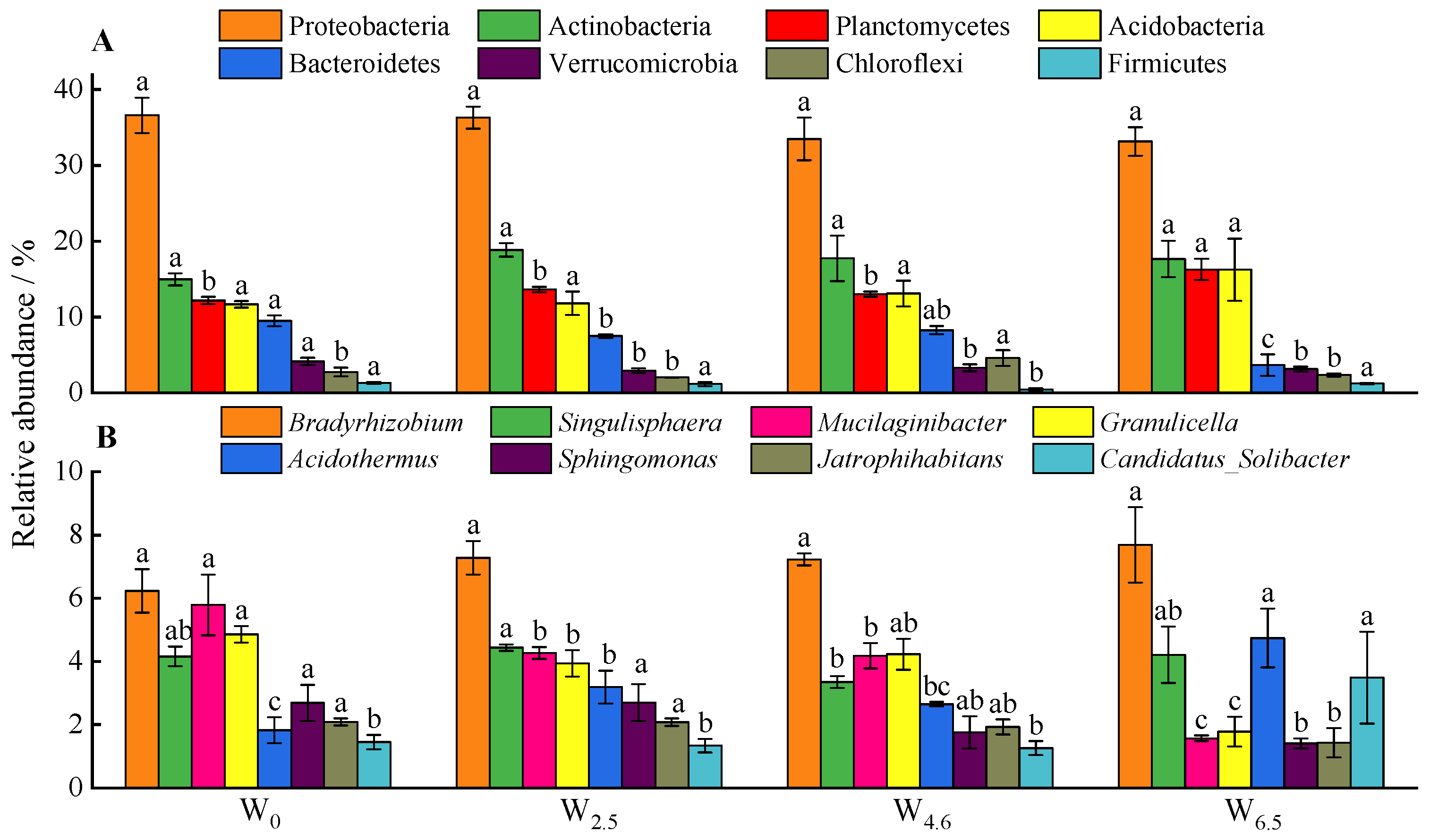

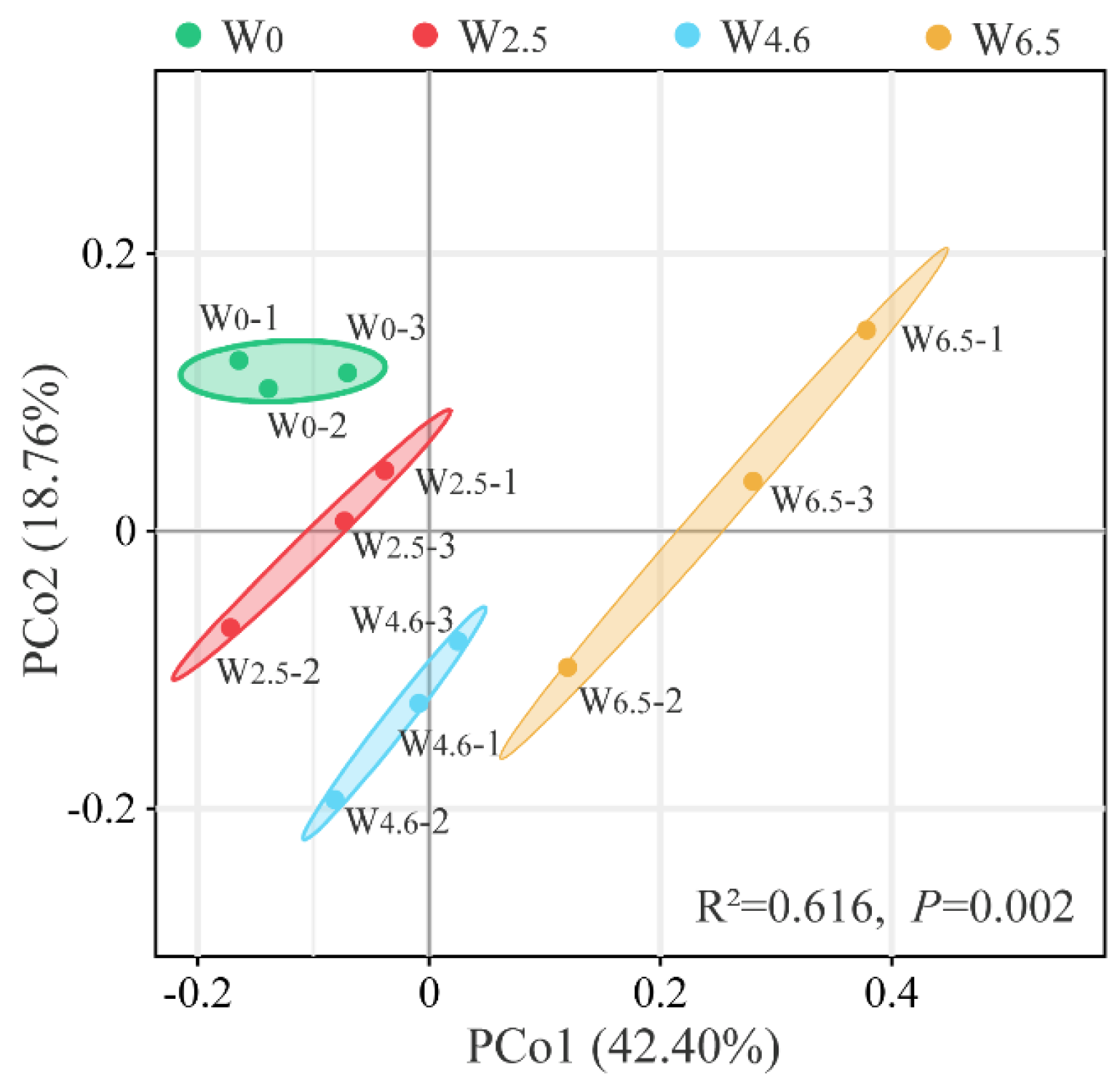
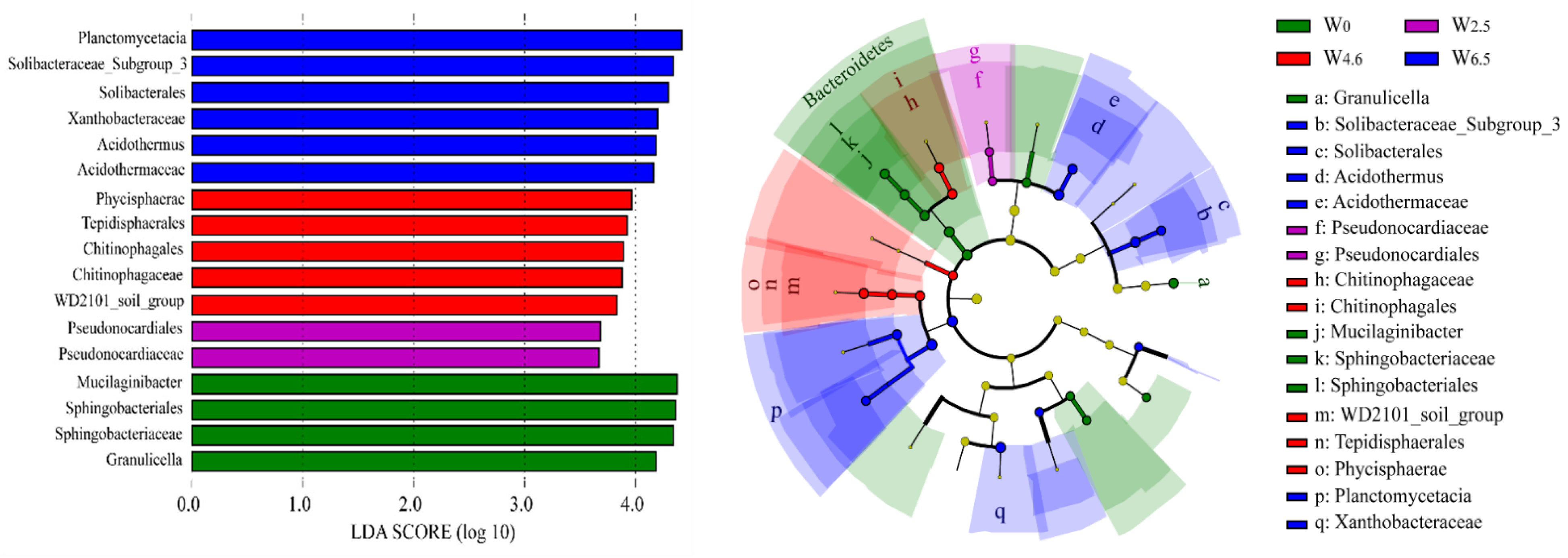
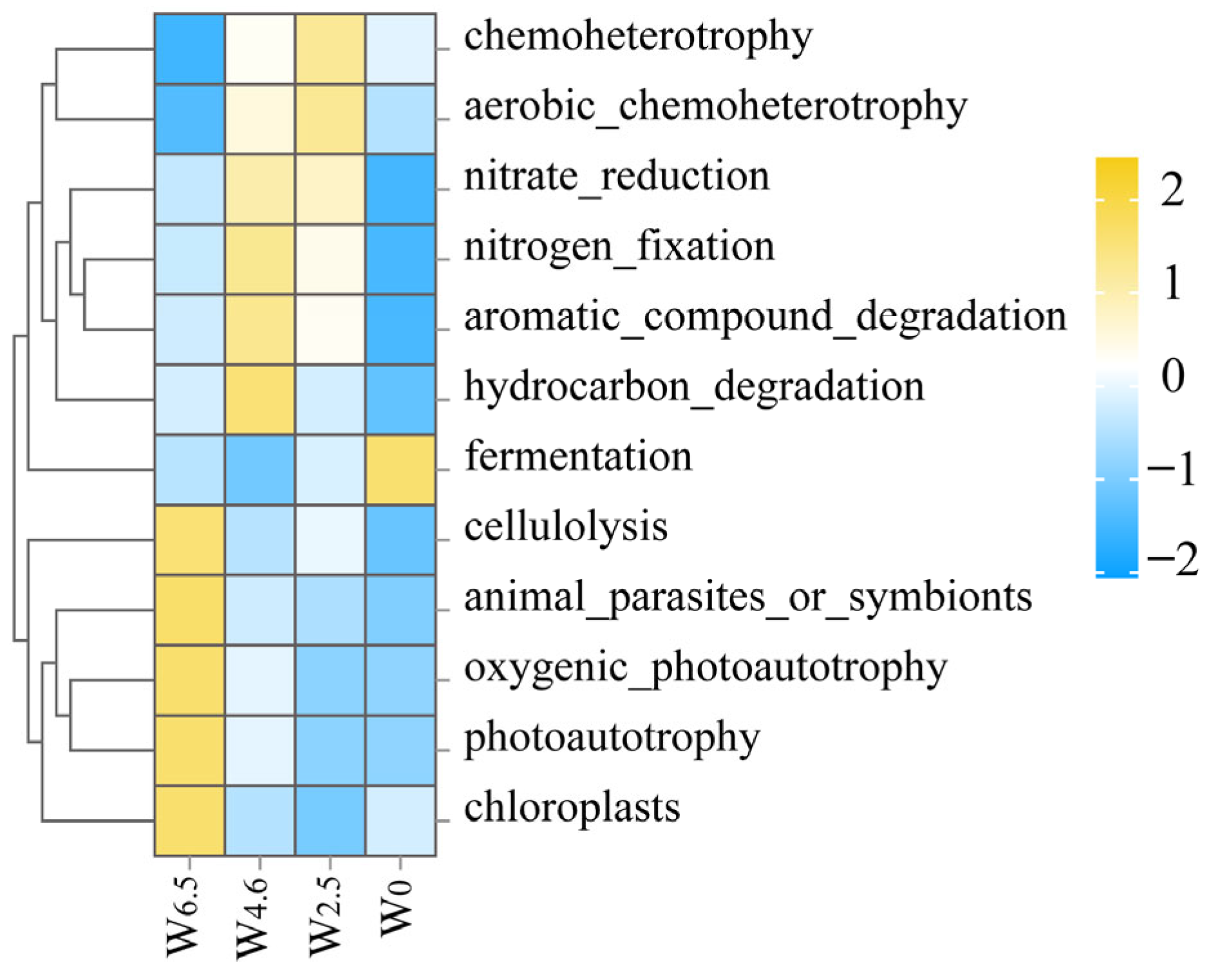

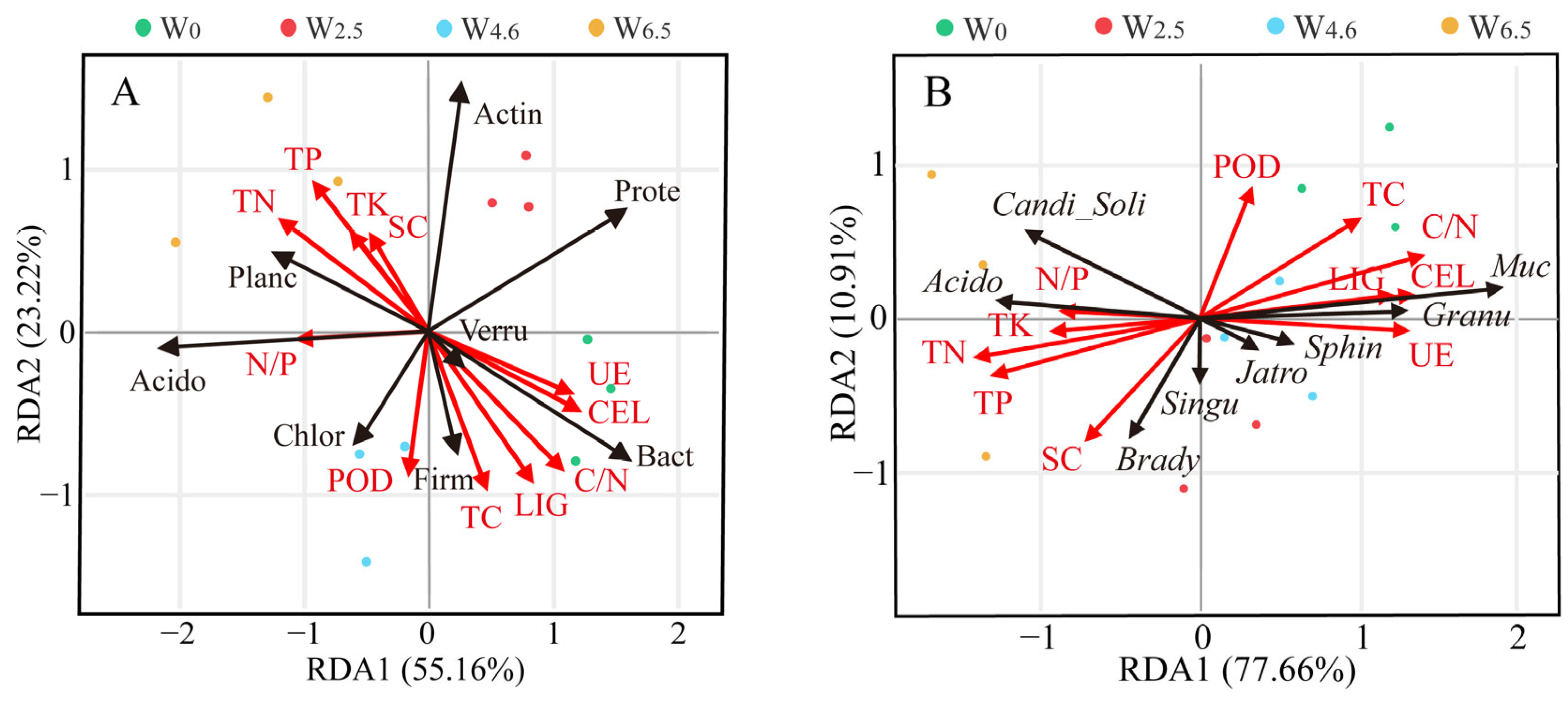
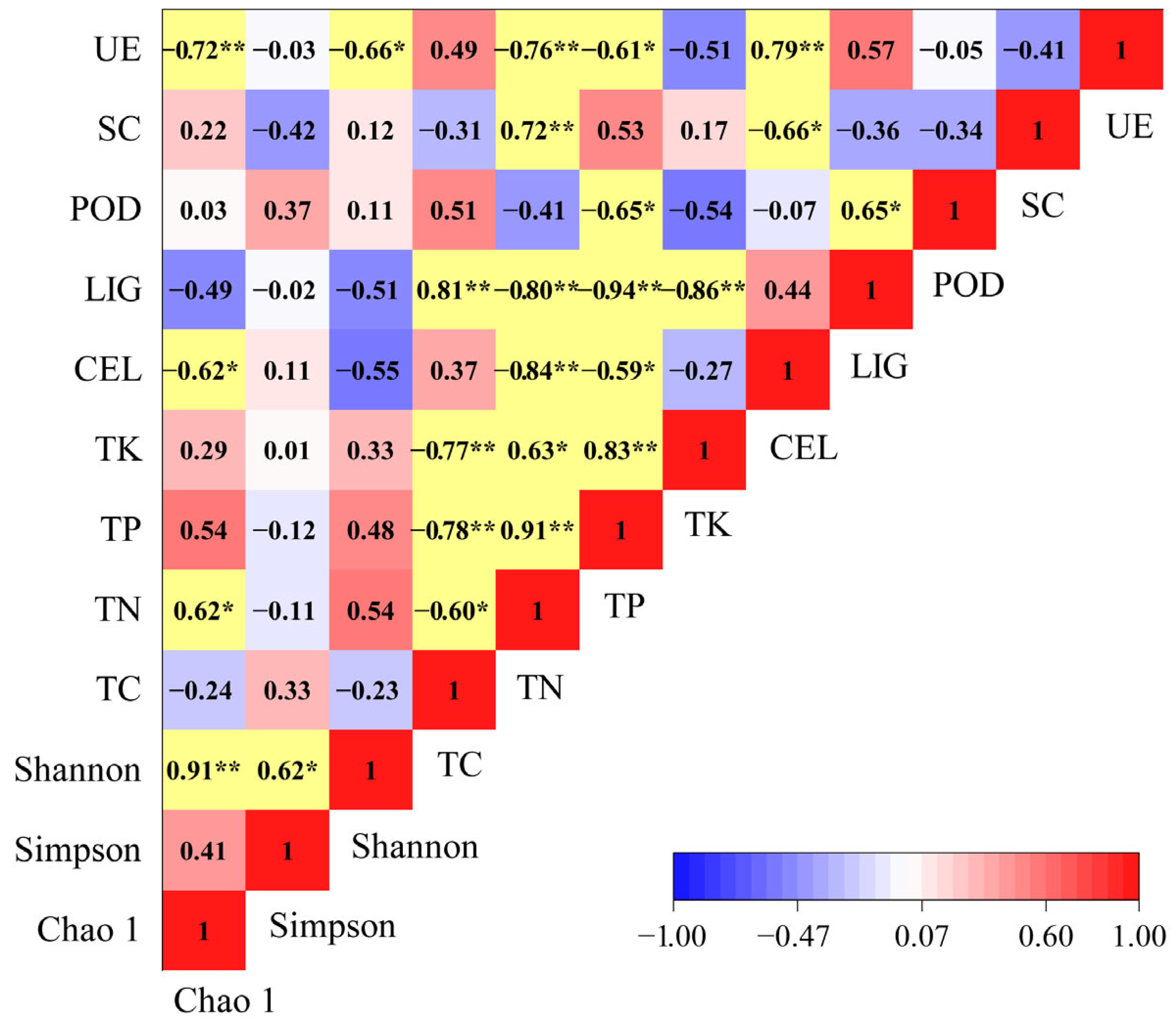
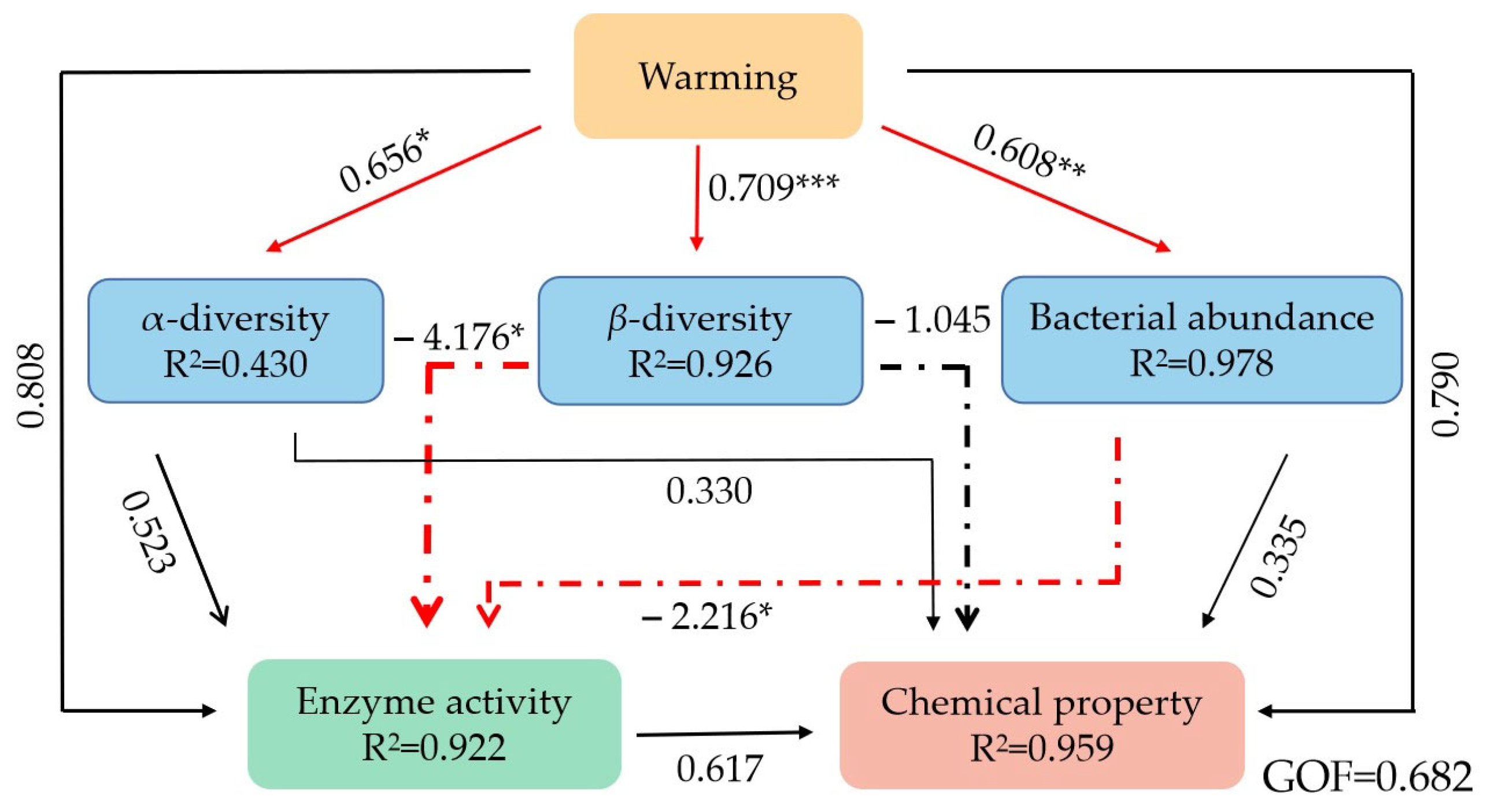
| Treatment | Longitude | Latitude | AAT (°C) | AAST (°C) | AAP (mm) | Average Tree Height (m) | Average DBH (cm) | Canopy Density |
|---|---|---|---|---|---|---|---|---|
| W0 | 117°44′54″ | 27°42′37″ | 10.4 | 11.5 | 3150 | 5.91 ± 1.14 | 8.09 ± 8.28 | 0.50 |
| W2.5 | 117°38′30″ | 27°44′03″ | 12.9 | 12.7 | 2450 | 8.46 ± 3.59 | 15.16 ± 4.84 | 0.75 |
| W4.6 | 117°44′14″ | 27°45′17″ | 15.0 | 14.8 | 2100 | 11.22 ± 5.25 | 20.22 ± 10.93 | 0.75 |
| W6.5 | 117°46′25″ | 27°50′41″ | 16.9 | 17.9 | 1900 | 15.49 ± 4.00 | 23.73 ± 10.30 | 0.85 |
| Treatment | Soil Layer (cm) | Soil Bulk Density (g/cm3) | Total Carbon (mg/g) | Total Nitrogen (mg/g) | Total Phosphorus (mg/g) | Soil pH |
|---|---|---|---|---|---|---|
| W0 | 0–10 | 0.97 ± 0.12 a | 6.92 ± 0.65 ab | 0.54 ± 0.04 Bbc | 0.30 ± 0.03 b | 4.59 ± 0.03 a |
| 10–20 | 1.05 ± 0.09 a | 5.58 ± 0.81 a | 0.79 ± 0.08 Aa | 0.28 ± 0.04 b | 4.56 ± 0.07 a | |
| W2.5 | 0–10 | 0.94 ± 0.10 a | 5.24 ± 0.68 bc | 0.71 ± 0.13 ab | 0.46 ± 0.06 a | 4.38 ± 0.06 b |
| 10–20 | 0.99 ± 0.11 a | 3.89 ± 0.52 b | 0.47 ± 0.09 b | 0.38 ± 0.03 a | 4.55 ± 0.04 a | |
| W4.6 | 0–10 | 0.86 ± 0.09 b | 8.04 ± 0.59 a | 0.77 ± 0.12 a | 0.30 ± 0.007 Ab | 4.41 ± 0.05 b |
| 10–20 | 0.90 ± 0.06 b | 6.44 ± 0.62 a | 0.74 ± 0.11 a | 0.20 ± 0.03 Bc | 4.54 ± 0.07 a | |
| W6.5 | 0–10 | 0.86 ± 0.18 ab | 4.24 ± 0.69 c | 0.43 ± 0.07 c | 0.32 ± 0.01 b | 4.67 ± 0.06 a |
| 10–20 | 1.00 ± 0.12 a | 3.41 ± 0.39 b | 0.38 ± 0.08 b | 0.28 ± 0.03 b | 4.58 ± 0.03 a |
| Treatment | Dry Weight Remaining (g) | Total Carbon (mg/g) | Total Nitrogen (mg/g) | Total Phosphorus (mg/g) | Total Potassium (mg/g) | Cellulose (mg/g) | Lignin (mg/g) |
|---|---|---|---|---|---|---|---|
| W0 | 7.83 ± 0.16 a | 490.63 ± 13.71 a | 12.26 ± 0.39 c | 0.438 ± 0.002 c | 0.62 ± 0.02 c | 421.25 ± 8.08 a | 230.94 ± 4.27 a |
| W2.5 | 7.65 ± 0.11 a | 477.06 ± 8.45 ab | 14.31 ± 0.34 b | 0.506 ± 0.009 b | 0.69 ± 0.02 b | 404.48 ± 20.85 a | 203.51 ± 10.61 b |
| W4.6 | 7.29 ± 0.14 b | 499.95 ± 10.87 a | 13.91 ± 0.35 b | 0.447 ± 0.003 c | 0.43 ± 0.01 d | 358.71 ± 9.40 b | 234.09 ± 8.74 a |
| W6.5 | 7.11 ± 0.13 b | 461.18 ± 17.88 b | 16.90 ± 0.16 a | 0.544 ± 0.007 a | 0.82 ± 0.03 a | 314.64 ± 6.85 c | 188.61 ± 5.74 c |
Disclaimer/Publisher’s Note: The statements, opinions and data contained in all publications are solely those of the individual author(s) and contributor(s) and not of MDPI and/or the editor(s). MDPI and/or the editor(s) disclaim responsibility for any injury to people or property resulting from any ideas, methods, instructions or products referred to in the content. |
© 2024 by the authors. Licensee MDPI, Basel, Switzerland. This article is an open access article distributed under the terms and conditions of the Creative Commons Attribution (CC BY) license (https://creativecommons.org/licenses/by/4.0/).
Share and Cite
Wu, X.; Li, J.; Zhu, J.; Jiang, Y.; Huang, Z.; Wu, P.; Ma, X. Effects of Simulated Warming on Bacterial Community Structure in Litters of Chinese Fir Based on Displacement Test. Forests 2024, 15, 908. https://doi.org/10.3390/f15060908
Wu X, Li J, Zhu J, Jiang Y, Huang Z, Wu P, Ma X. Effects of Simulated Warming on Bacterial Community Structure in Litters of Chinese Fir Based on Displacement Test. Forests. 2024; 15(6):908. https://doi.org/10.3390/f15060908
Chicago/Turabian StyleWu, Xiaojian, Jiangfei Li, Jianing Zhu, Yu Jiang, Zhijun Huang, Pengfei Wu, and Xiangqing Ma. 2024. "Effects of Simulated Warming on Bacterial Community Structure in Litters of Chinese Fir Based on Displacement Test" Forests 15, no. 6: 908. https://doi.org/10.3390/f15060908






